Effect of Peak Temperatures on Microstructure and Properties of Welding Coarse Grain Heat-Affected Zone of SA508 Gr.4N Steel
Abstract
:1. Introduction
2. Experimental Procedure
2.1. Experimental Materials Preparation
2.2. Experimental Procedure
3. Results and Discussion
3.1. Grain Growth Behavior at Different t8/5 Time
3.2. Effect of Peak Temperature on Grain Growth
3.3. Kinetics of Grain Growth
3.4. Phase Transition at Different Peak Temperatures
3.5. Vickers Hardness
4. Conclusions
- (1)
- The average grain size of SA508 Gr.4N steel was 25.53 μm after forging annealing. Compared with the original state, the grain size increased obviously after the welding heat-affected zone simulation. Moreover, the proportion of large grain size increased, and the grains were not uniform. The simulation at different peak temperatures and t8/5 time shows that the regular grain growth at the same peak temperature is independent of t8/5 time. The peak temperature has a great influence on grain growth. The average grain size corresponding to the peak temperatures of 1200 °C, 1250 °C and 1300 °C were 51.847 μm, 68.022 μm and 101.247 μm, respectively. The fitting results of grain size distribution under various experimental conditions basically accord with regular Gaussian normal distribution. The grain growth dynamics model of welded SA508 Gr.4N steel in the coarse grain heat-affected zone has been established.
- (2)
- Martensite and a small amount of retained austenite formed in SA508 Gr.4N steel, after a thermal simulation test in welded coarse grain heat-affected zone (CGHAZ) under various experimental conditions. There are martensite structures with different orientation relationships in the same primary austenite grain. The microstructure of martensite became coarse with the increase in peak temperatures, but t8/5 time had little effect on the microstructure of martensite. Carbides and M-A islands were formed during the microstructure’s transformation.
- (3)
- The Vickers hardness of SA508 Gr.4N steel is 309.7 HV after the forging’s annealing. After simulating, the Vickers hardness of the tested steel is within the range of martensite hardness. The Vickers hardness of the tested steel has little difference after different peak temperatures and t8/5 time. It is known that the Vickers hardness is closely related to the microstructure of the material at room temperature, while the grain size has less effect.
Author Contributions
Funding
Data Availability Statement
Acknowledgments
Conflicts of Interest
References
- Lee, K.H.; Kim, M.C.; Lee, B.S.; Wee, D.M. Master curve characterization of the fracture toughness behavior in SA508 Gr.4N low alloy steels. J. Nucl. Mater. 2010, 403, 68–74. [Google Scholar] [CrossRef]
- Spence, J.; Nash, D.H. Milestones in pressure vessel technology. Int. J. Press. Vessels. Pip. 2004, 81, 89–118. [Google Scholar] [CrossRef]
- Druce, S.G.; Edwards, B.C. Development of PWR pressure vessle steels. Nucl. Energy 1980, 19, 347. [Google Scholar]
- Lee, B.S.; Kim, M.C.; Yoon, J.H.; Hong, J.H. Characterization of high strength and high toughness Ni–Mo–Cr low alloy steels for nuclear application. Int. J. Press. Vessels. Pip. 2010, 87, 74–80. [Google Scholar] [CrossRef]
- Odette, G.R. On the dominant mechanism of irradiation embrittlement of reactor pressure vessel steels. Scr. Metall. 1983, 17, 1183–1188. [Google Scholar] [CrossRef]
- Park, S.G.; Lee, K.H.; Min, K.D.; Kim, M.C.; Lee, B.S. Influence of the thermodynamic parameters on the temper embrittlement of SA508 Gr.4N Ni–Cr–Mo low alloy steel with variation of Ni, Cr and Mn contents. J. Nucl. Mater. 2012, 426, 1–8. [Google Scholar] [CrossRef]
- Park, S.G.; Kim, M.C.; Lee, B.S.; Wee, D.M. Correlation of the thermodynamic calculation and the experimental observation of Ni–Mo–Cr low alloy steel changing Ni, Mo, and Cr contents. J. Nucl. Mater. 2010, 407, 126–135. [Google Scholar] [CrossRef]
- Lee, B.S.; Kim, M.C.; Kim, M.W.; Yoon, J.H.; Hong, J.H. Master curve techniques to evaluate an irradiation embrittlement of nuclear reactor pressure vessels for a long-term operation. Int. J. Press. Vessels. Pip. 2008, 85, 593–599. [Google Scholar] [CrossRef]
- Li, Y.L.; Fu, L.M.; Yu, L.K. Investigation of non-equilibrium grain boundary segregation on CGHAZ in reactor pressure vessel steel. Sci. Technol. Weld. Join. 2015, 20, 395–401. [Google Scholar] [CrossRef]
- Zhang, J.; Xin, W.B.; Luo, G.P.; Wang, R.F.; Meng, Q.Y.; Xian, S.T. Effect of welding heat input on microstructural evolution, precipitation behavior and resultant properties of the simulated CGHAZ in high-N V-alloyed steel. Mater. Charact. 2020, 162, 110201. [Google Scholar] [CrossRef]
- Li, L.Y.; Wang, Y.; Han, T.; Li, C.W. Embrittlement and toughening in CGHAZ of ASTM4130 steel. Sci. China Phys. Mech. Astron. 2011, 54, 1447–1454. [Google Scholar] [CrossRef]
- Kim, S.; Kang, S.Y.; Lee, S.; Oh, S.J.; Kwon, S.J.; Kim, O.H.; Hong, J.H. Correlation of the microstructure and fracture toughness of the heat-affected zones of an SA 508 steel. Metall. Mater. Trans. A 2000, 31, 1107–1119. [Google Scholar] [CrossRef] [Green Version]
- Kuo, H.T.; Wei, R.C.; Wu, W.F.; Yang, J.R. Simulated heat affected zone in ASTM A533-B steel plates under low heat inputs. Mater. Chem. Phys. 2009, 117, 471–477. [Google Scholar] [CrossRef]
- Million, K.; Datta, R.; Zimmermann, H. Effects of heat input on the microstructure and toughness of the 8MnMoNi55 shape-welded nuclear steel. J. Nucl. Mater. 2005, 340, 25–32. [Google Scholar] [CrossRef]
- Zhu, Z.X.; Marimuthu, M.; Kuzmikova, L.; Li, H.J.; Barbaro, F.; Zheng, L.; Bai, M.Z.; Jones, C. Influence of Ti/N ratio on simulated CGHAZ microstructure and toughness in X70 steels. Sci. Technol. Weld. Join. 2013, 18, 45–51. [Google Scholar] [CrossRef] [Green Version]
- Lee, K.H.; Jhung, M.J.; Kim, M.C.; Lee, B.S. Effects of tempering and PWHT on microstructures and mechanical properties of SA508 Gr.4N steel. Nucl. Eng. Technol. 2014, 46, 413–422. [Google Scholar] [CrossRef] [Green Version]
- Brayshaw, W.J.; Cooper, A.J.; Sherry, A.H. Assessment of the micro-mechanical fracture processes within dissimilar metal welds. Eng. Fail. Anal. 2019, 97, 820–835. [Google Scholar] [CrossRef]
- Sun, Y.L.; Vasileiou, A.N.; Pickering, E.J.; Collins, J.; Obasi, G.; Akrivos, V.; Smith, M.C. Impact of weld restraint on the development of distortion and stress during the electron beam welding of a low-alloy steel subject to solid state phase transformation. Int. J. Mech. Sci. 2021, 196, 106244. [Google Scholar] [CrossRef]
- Mohammadijoo, M.; Valloton, J.; Collins, L.; Henein, H.; Ivey, D.G. Characterization of martensite-austenite constituents and micro-hardness in intercritical reheated and coarse-grained heat affected zones of API X70 HSLA steel. Mater. Charact. 2018, 142, 321–331. [Google Scholar] [CrossRef]
- Li, G.; Lu., X.F.; Zhu., X.L.; Huang., J.; Liu., L.W.; Wu. Y., X. The segregation and liquation crackings in the HAZ of multipass laser-welded joints for nuclear power plants. J. Mater. Eng. Perform. 2017, 26, 4083–4091. [Google Scholar] [CrossRef]
- Pugacheva, N.B.; Zadvorkin, S.M.; Michurov, N.S. EBSD analysis of an austenitic Cr-Ni steel laser weld. Phys. Met. Metallogr. 2022, 123, 791–796. [Google Scholar] [CrossRef]
- ASTM SA-508/SA-508M; Specification for Quenched and Tempered Vacuum-Treated Carbon and Alloy Steel Forgings for Pressure Vessels. ASTM International: West Conshohocken, PA, USA, 2004; pp. 939–948.
- Anelli, E. Application of mathematical modeling to hot rolling and controlled cooling of wire rods and bars. ISIJ Int. 1992, 32, 440–449. [Google Scholar] [CrossRef]
- Sellars, C.M.; Whiteman, J.A. Recrystallization and grain growth in hot rolling. Met. Sci. 1979, 13, 187–194. [Google Scholar] [CrossRef]
- Beck, P.A.; Kremer, J.C.; Demer, L. Grain growth in high-purity aluminium-magnesium alloy. Met. Mater. Trans. 1948, 175, 372–394. [Google Scholar]
- Yan, B.Y.; Liu, Y.H.; Wang, Z.J.; Liu, C.X.; Si, Y.H.; Li, H.J.; Yu, J.X. The Effect of Precipitate Evolution on Austenite Grain Growth in RAFM Steel. Materials 2017, 10, 1017. [Google Scholar] [CrossRef] [Green Version]
- Shahandeh, S.; Milizer, M. Grain boundary curvature and grain growth kinetics with particle pinning. Phllos. Mag. 2013, 93, 3231–3247. [Google Scholar] [CrossRef]
- Yang, Z.Q.; Liu, Z.D.; He, X.K.; Qiao, S.B.; Xie, C.S. Effect of microstructure on the impact toughness and temper embrittlement of SA508Gr.4N steel for advanced pressure vessel materials. Sci. Rep. 2018, 8, 207–219. [Google Scholar] [CrossRef] [Green Version]
- Takahashi, M.; Bhadeshia, H.K.D.H. The interpretation of dilatometric data for transformations in steels. J. Mater. Sci. Lett. 1989, 8, 477–478. [Google Scholar] [CrossRef]
- Onink, M.; Tichelaar, F.D.; Brakman, C.M.; Mittemeijer, E.J.; Zwaag, S.; Metallkd, Z. Quantitative analysis of the dilatation by decomposition of Fe-C austenites; Calculation of volume change upon transformation. Int. J. Mater. Res. 1996, 12, 469–495. [Google Scholar] [CrossRef]
- Wang, X.; Chen, J.G.; Su, G.F.; Li, H.Y.; Wang, C. Plastic damage evolution in structural steel and its non-destructive evaluation. J. Mater. Res. Technol. 2020, 9, 1189–1199. [Google Scholar] [CrossRef]
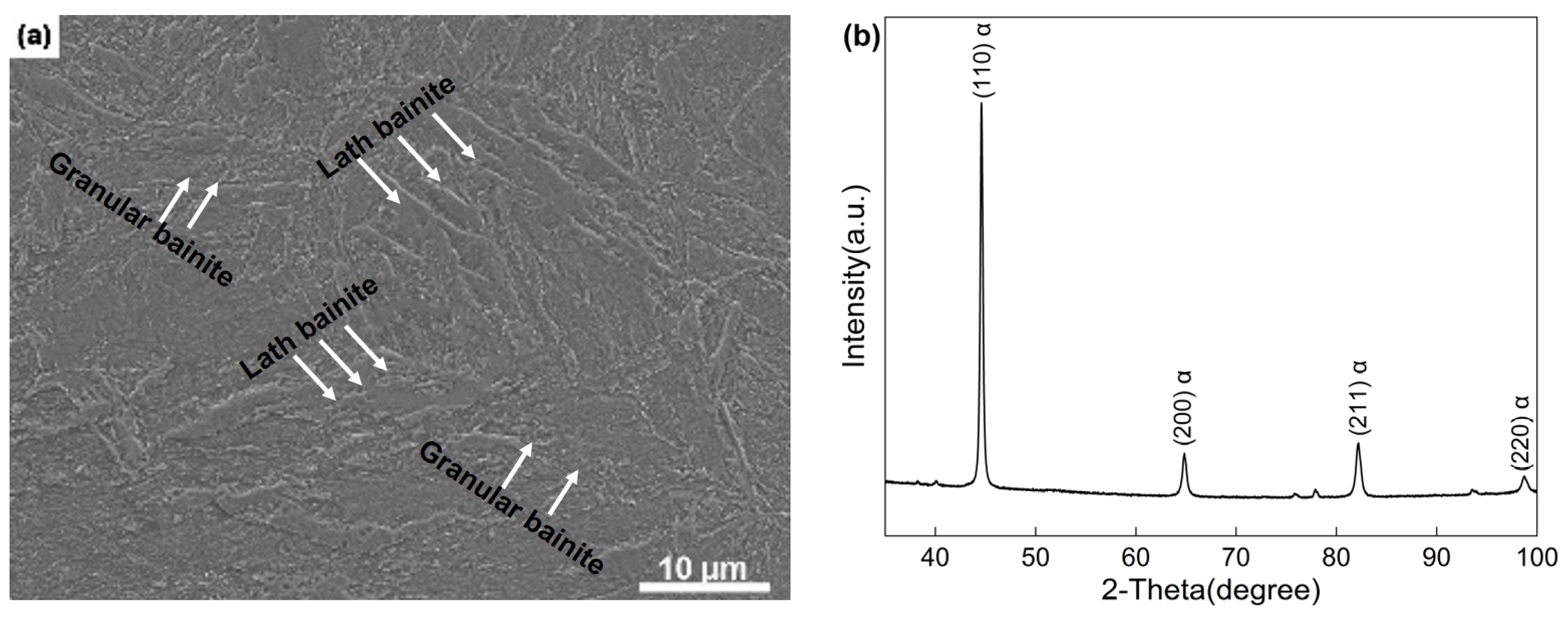
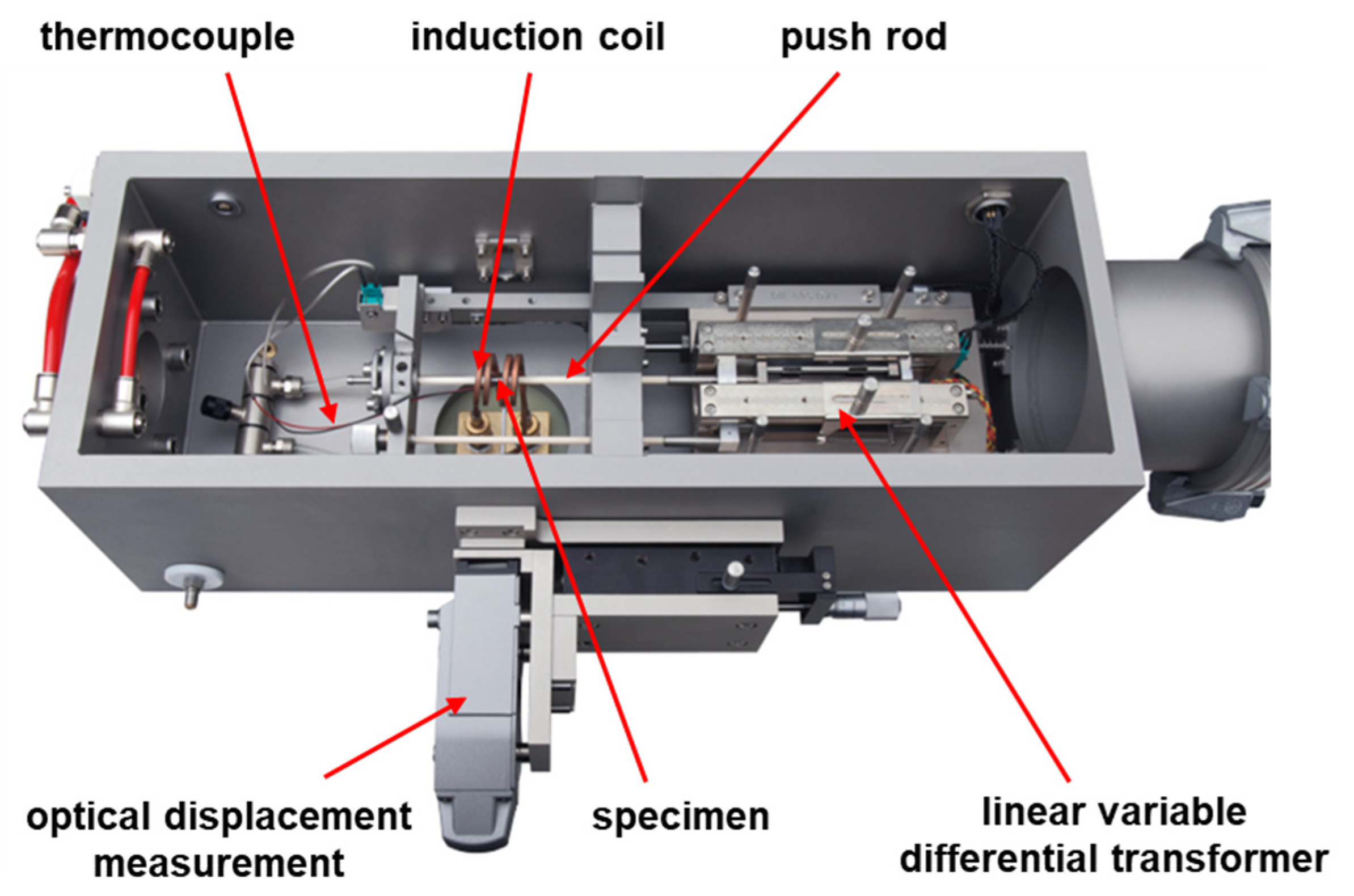


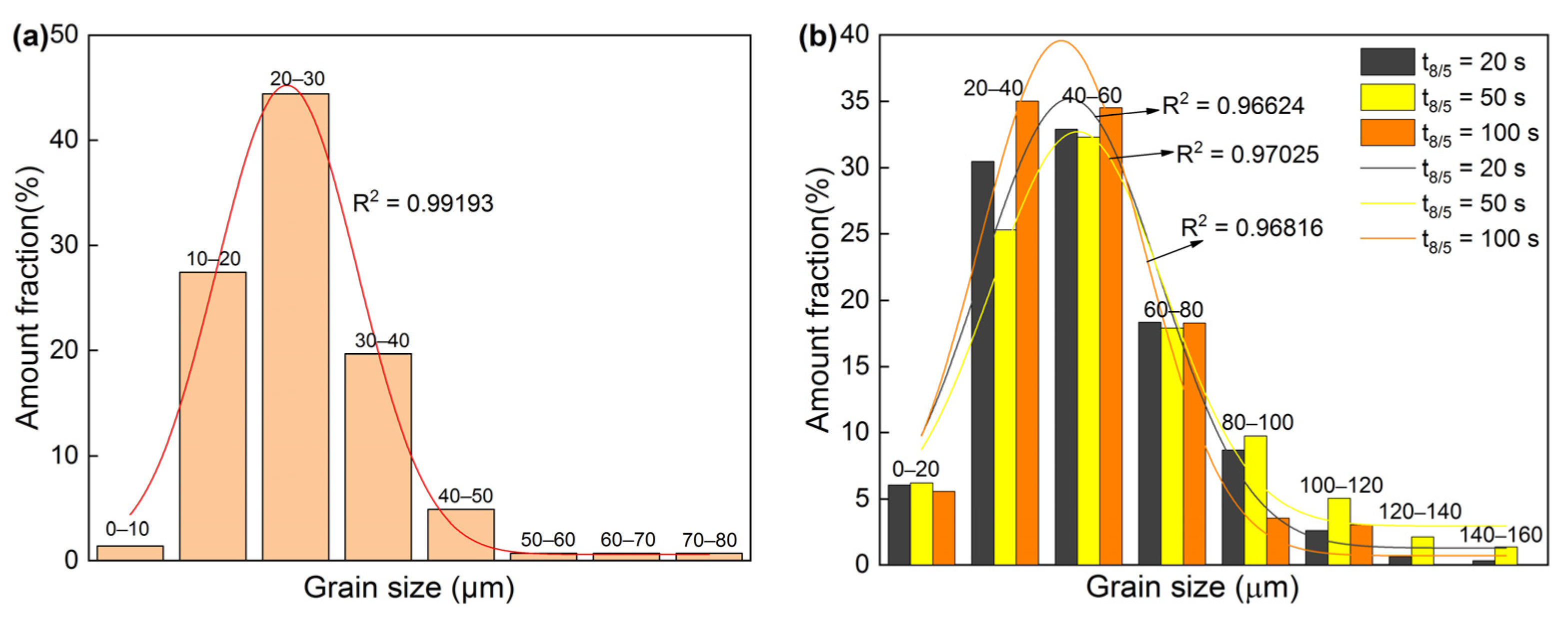



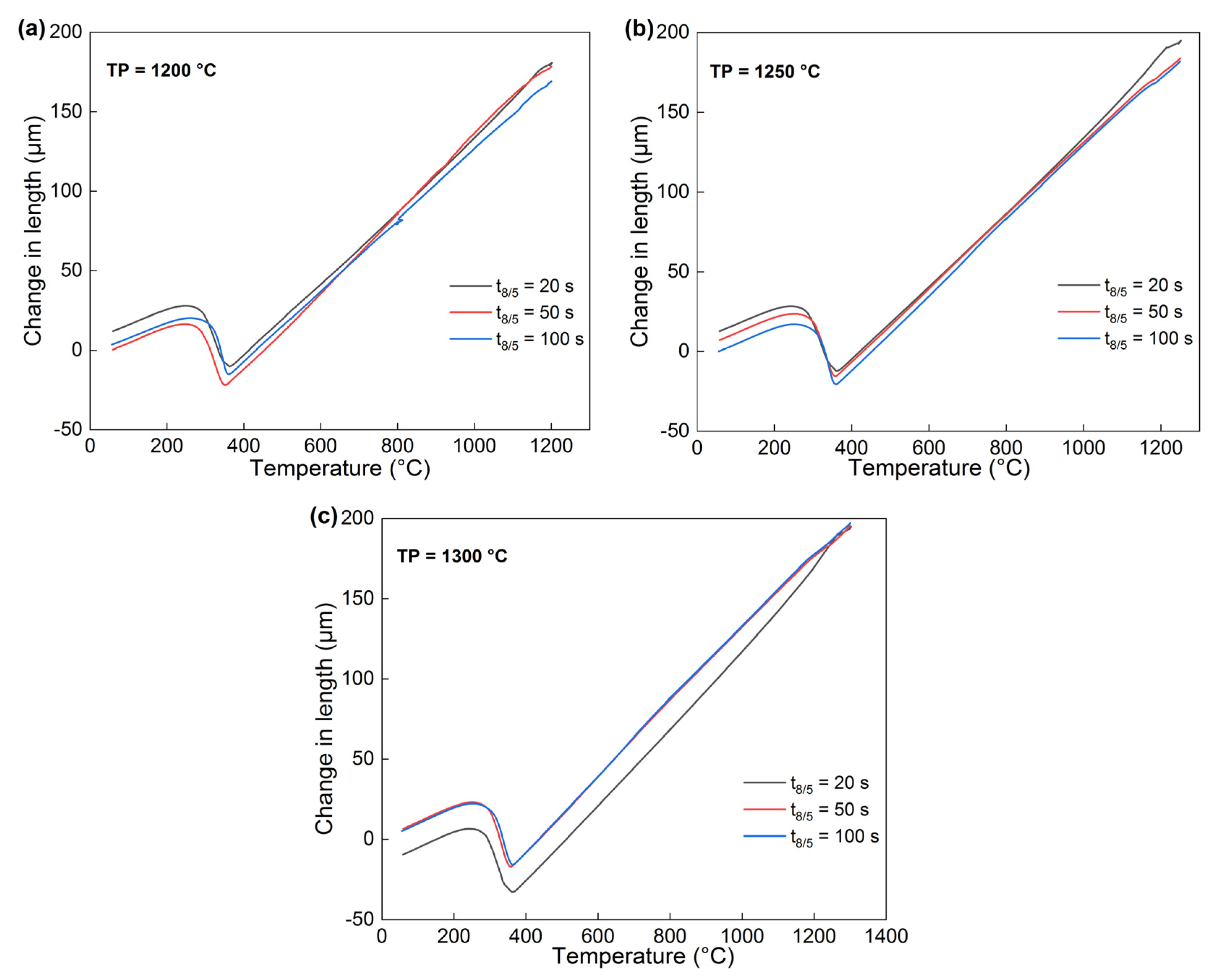

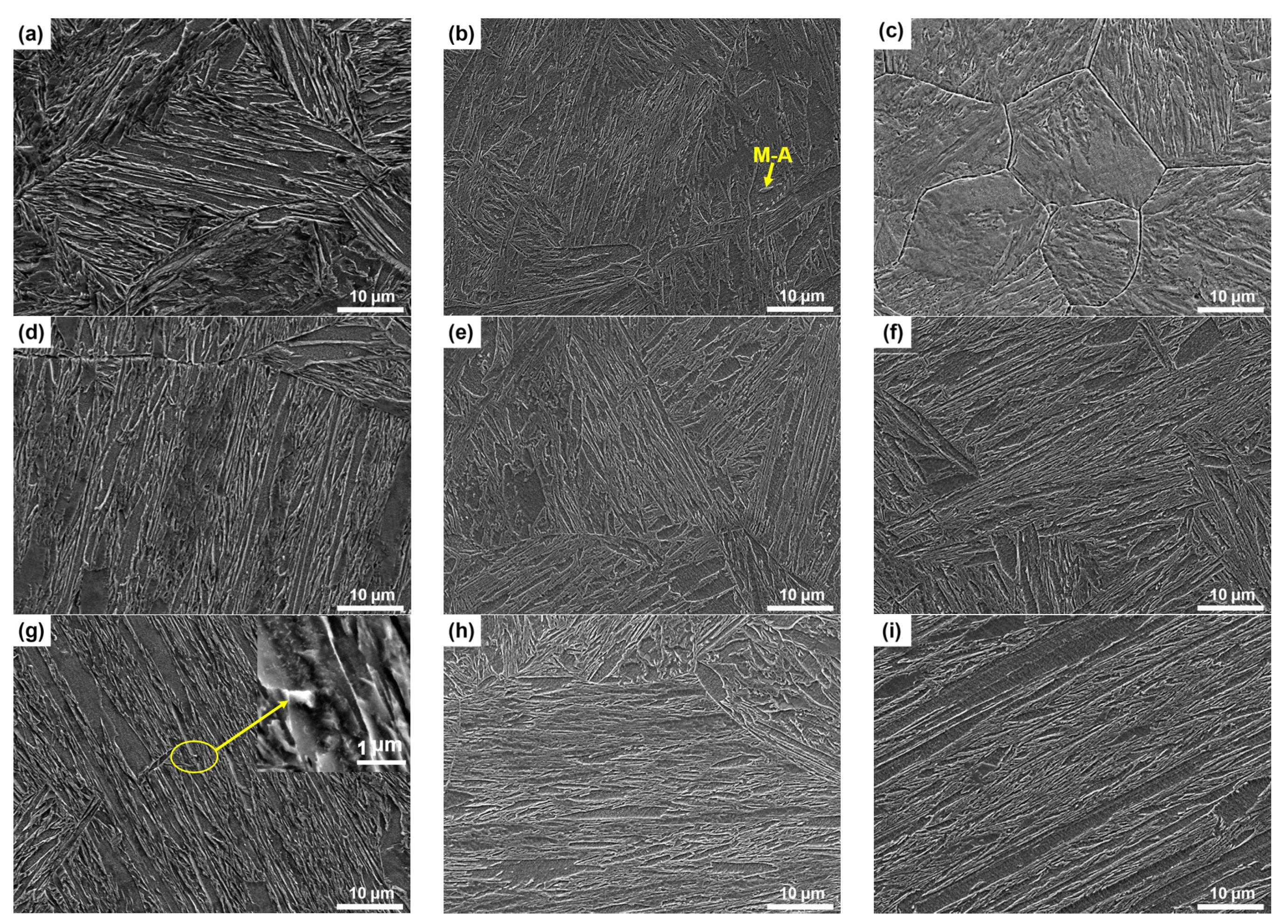
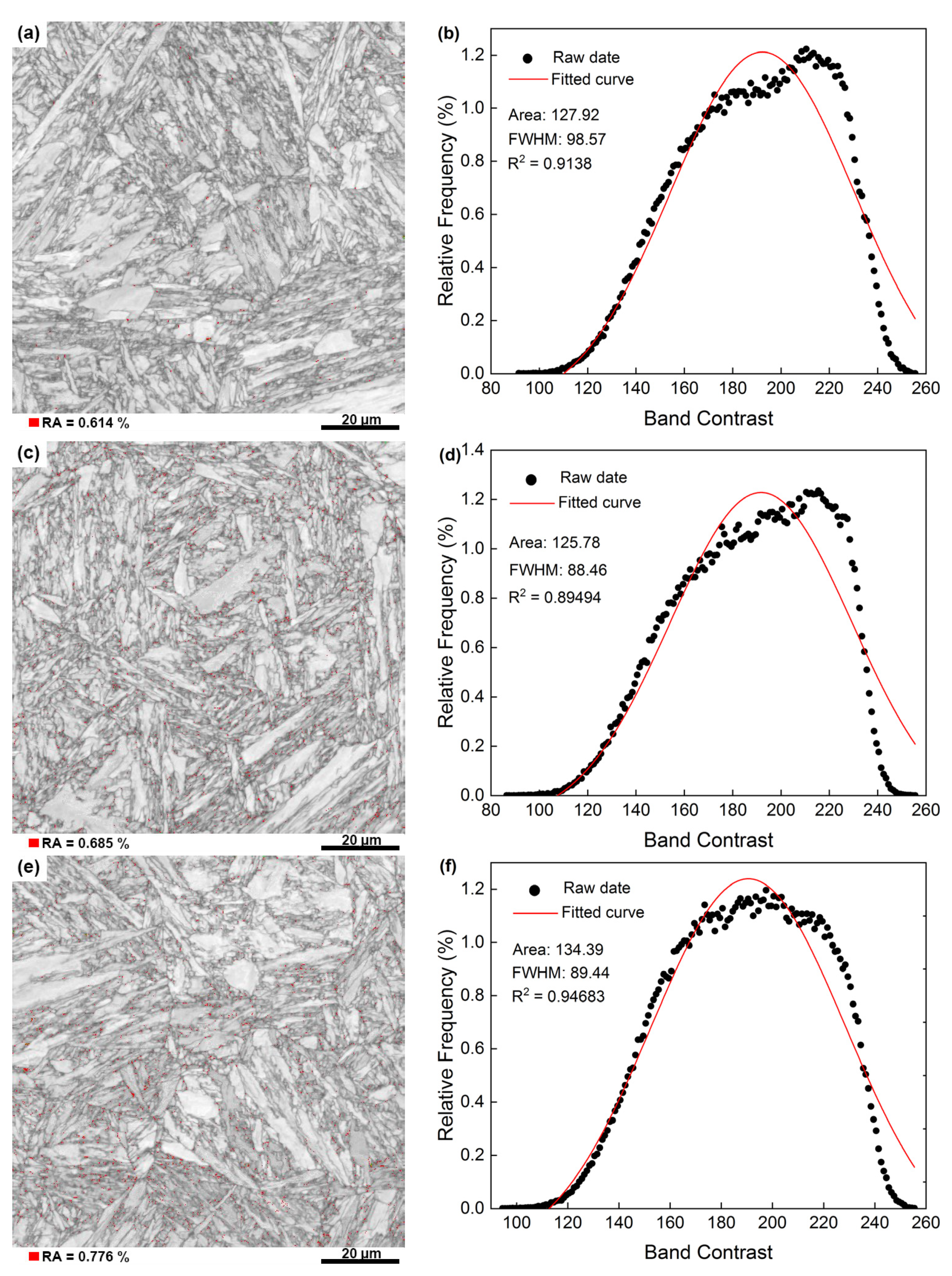
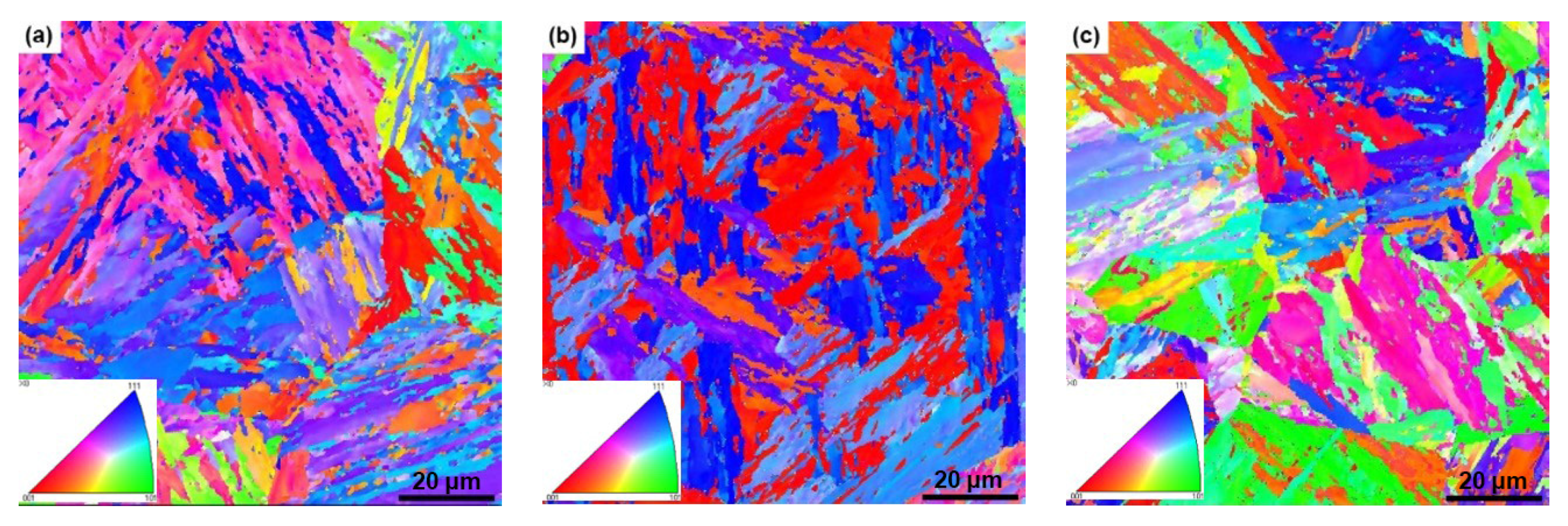
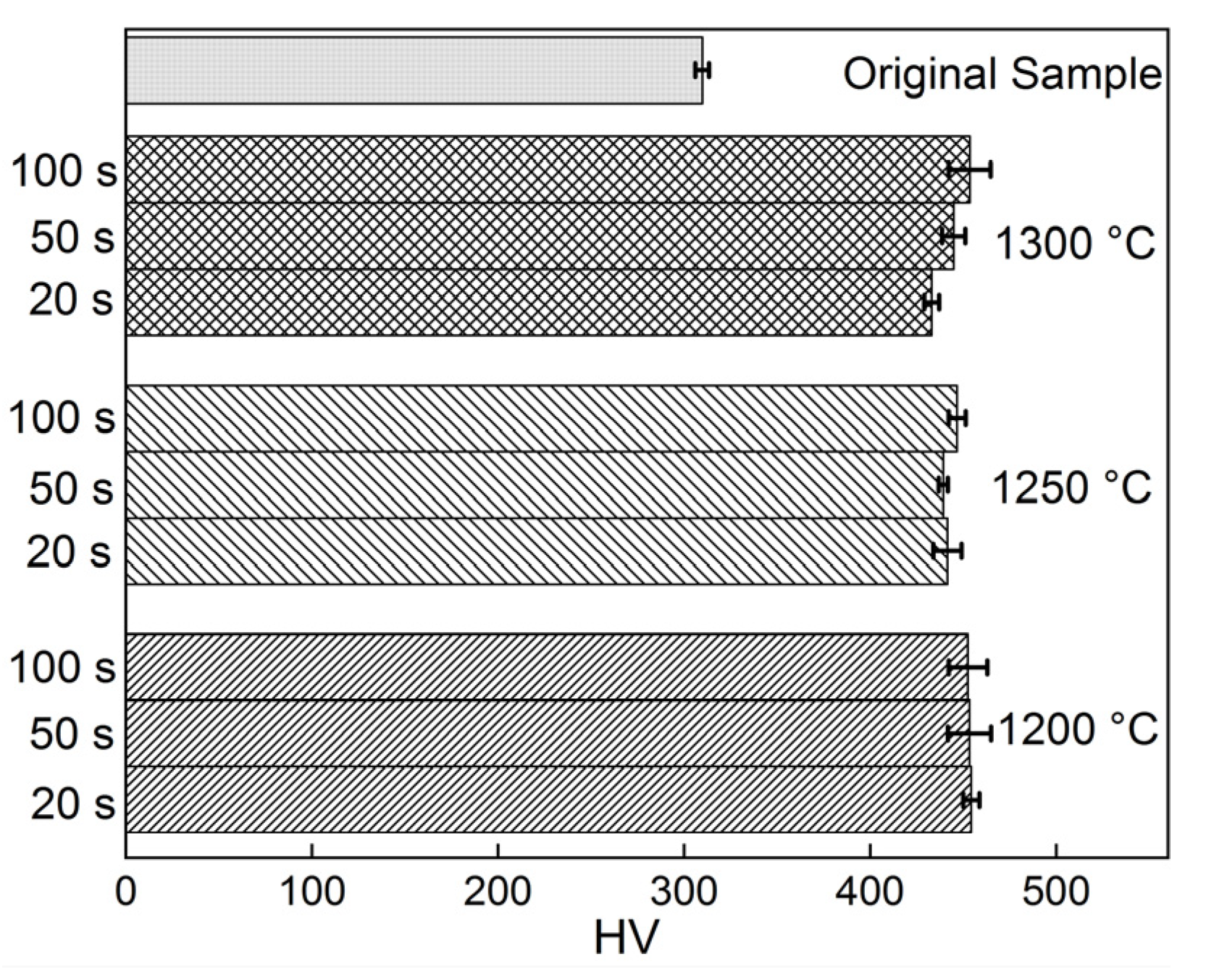
| Element | C | Si | Mn | P | S | Ni | Cr | Mo | V | Cu | Fe |
|---|---|---|---|---|---|---|---|---|---|---|---|
| Contents | 0.18 | 0.05 | 0.34 | 0.002 | 0.001 | 3.80 | 1.77 | 0.53 | 0.02 | 0.01 | Bal. |
| Grain Size (μm) | |||||
|---|---|---|---|---|---|
| Temperature (°C) | 1000 | 1100 | 1200 | 1250 | 1300 |
| Experiment | 8.27 | 19.57 | 51.85 | 68.02 | 101.25 |
| Model | 9.03 | 22.67 | 50.24 | 71.93 | 100.66 |
| T/°C | 1200 | 1250 | 1300 | Original | ||||||
|---|---|---|---|---|---|---|---|---|---|---|
| t8/5/s | 20 | 50 | 100 | 20 | 50 | 100 | 20 | 50 | 100 | |
| HV | 454.30 | 453.28 | 452.54 | 441.52 | 439.26 | 446.72 | 433.08 | 444.84 | 453.46 | 309.70 |
Disclaimer/Publisher’s Note: The statements, opinions and data contained in all publications are solely those of the individual author(s) and contributor(s) and not of MDPI and/or the editor(s). MDPI and/or the editor(s) disclaim responsibility for any injury to people or property resulting from any ideas, methods, instructions or products referred to in the content. |
© 2022 by the authors. Licensee MDPI, Basel, Switzerland. This article is an open access article distributed under the terms and conditions of the Creative Commons Attribution (CC BY) license (https://creativecommons.org/licenses/by/4.0/).
Share and Cite
Lu, S.; Wan, L.; Yang, H.; Zheng, S.; Li, M.; Duan, Y.; Xu, Z. Effect of Peak Temperatures on Microstructure and Properties of Welding Coarse Grain Heat-Affected Zone of SA508 Gr.4N Steel. Metals 2023, 13, 50. https://doi.org/10.3390/met13010050
Lu S, Wan L, Yang H, Zheng S, Li M, Duan Y, Xu Z. Effect of Peak Temperatures on Microstructure and Properties of Welding Coarse Grain Heat-Affected Zone of SA508 Gr.4N Steel. Metals. 2023; 13(1):50. https://doi.org/10.3390/met13010050
Chicago/Turabian StyleLu, Shumeng, Li Wan, Hongfu Yang, Shanju Zheng, Mengnie Li, Yonghua Duan, and Zhongdong Xu. 2023. "Effect of Peak Temperatures on Microstructure and Properties of Welding Coarse Grain Heat-Affected Zone of SA508 Gr.4N Steel" Metals 13, no. 1: 50. https://doi.org/10.3390/met13010050




